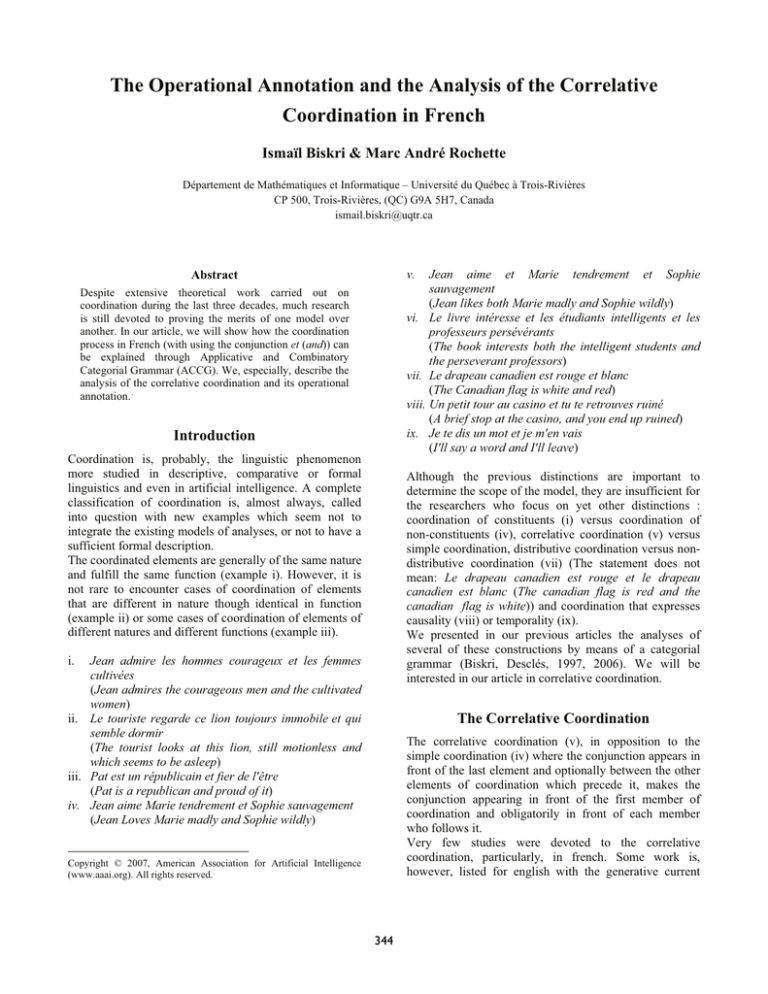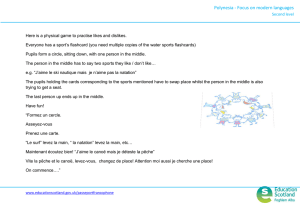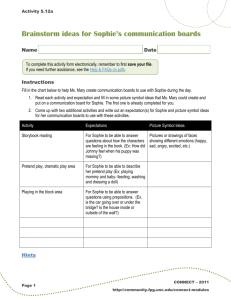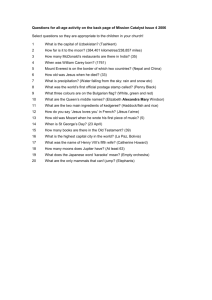
The Operational Annotation and the Analysis of the Correlative
Coordination in French
Ismaïl Biskri & Marc André Rochette
Département de Mathématiques et Informatique – Université du Québec à Trois-Rivières
CP 500, Trois-Rivières, (QC) G9A 5H7, Canada
ismail.biskri@uqtr.ca
v.
Jean aime et Marie tendrement et Sophie
sauvagement
(Jean likes both Marie madly and Sophie wildly)
vi. Le livre intéresse et les étudiants intelligents et les
professeurs persévérants
(The book interests both the intelligent students and
the perseverant professors)
vii. Le drapeau canadien est rouge et blanc
(The Canadian flag is white and red)
viii. Un petit tour au casino et tu te retrouves ruiné
(A brief stop at the casino, and you end up ruined)
ix. Je te dis un mot et je m'en vais
(I'll say a word and I'll leave)
Abstract
Despite extensive theoretical work carried out on
coordination during the last three decades, much research
is still devoted to proving the merits of one model over
another. In our article, we will show how the coordination
process in French (with using the conjunction et (and)) can
be explained through Applicative and Combinatory
Categorial Grammar (ACCG). We, especially, describe the
analysis of the correlative coordination and its operational
annotation. .
Introduction
Coordination is, probably, the linguistic phenomenon
more studied in descriptive, comparative or formal
linguistics and even in artificial intelligence. A complete
classification of coordination is, almost always, called
into question with new examples which seem not to
integrate the existing models of analyses, or not to have a
sufficient formal description.
The coordinated elements are generally of the same nature
and fulfill the same function (example i). However, it is
not rare to encounter cases of coordination of elements
that are different in nature though identical in function
(example ii) or some cases of coordination of elements of
different natures and different functions (example iii).
Although the previous distinctions are important to
determine the scope of the model, they are insufficient for
the researchers who focus on yet other distinctions :
coordination of constituents (i) versus coordination of
non-constituents (iv), correlative coordination (v) versus
simple coordination, distributive coordination versus nondistributive coordination (vii) (The statement does not
mean: Le drapeau canadien est rouge et le drapeau
canadien est blanc (The canadian flag is red and the
canadian flag is white)) and coordination that expresses
causality (viii) or temporality (ix).
We presented in our previous articles the analyses of
several of these constructions by means of a categorial
grammar (Biskri, Desclés, 1997, 2006). We will be
interested in our article in correlative coordination.
Jean admire les hommes courageux et les femmes
cultivées
(Jean admires the courageous men and the cultivated
women)
ii. Le touriste regarde ce lion toujours immobile et qui
semble dormir
(The tourist looks at this lion, still motionless and
which seems to be asleep)
iii. Pat est un républicain et fier de l'être
(Pat is a republican and proud of it)
iv. Jean aime Marie tendrement et Sophie sauvagement
(Jean Loves Marie madly and Sophie wildly)
i.
The Correlative Coordination
The correlative coordination (v), in opposition to the
simple coordination (iv) where the conjunction appears in
front of the last element and optionally between the other
elements of coordination which precede it, makes the
conjunction appearing in front of the first member of
coordination and obligatorily in front of each member
who follows it.
Very few studies were devoted to the correlative
coordination, particularly, in french. Some work is,
however, listed for english with the generative current
Copyright © 2007, American Association for Artificial Intelligence
(www.aaai.org). All rights reserved..
344
(Sag, 2005; Schwarz, 1999; Hendriks, 2004), from the
point of view of translinguistic generalization
Johannessen, 2005; Zoerner, 1999; De Vries, 2005).
Other studies are still too recent and restricted with only
coordinations of constituents. These studies made it
possible to better understand correlative coordinations.
Thus, we learn that they observe the same constraints of
parallelism as simple coordinations. They must share the
syntactic properties imposed by the context of appearance
of the elements coordinated, and lastly they can connect
not only constituents (vi) but also non-constituents (v).
We find two diagrams for the analysis of the correlative
coordination:
x A symmetrical analysis (Piot, 2000; Sag, 2005;
Progovac, 1998) for which each member of
coordination is introduced by the same
conjunction;
x An asymmetrical analysis (Johanessen, 2005;
Hendriks, 2004) which consists in regarding the
initial conjunction as an adverbial modifier.
Critics were formulated. Thus, some reject, categorically,
the fact of recognizing to the initial conjunction an
adverbial function, because of constraints of prosody.
Others reproach to the symmetrical analysis the fact of
considering the initial conjunction as a coordinating head
whereas this one does not coordinate (Johanessen, 2005)
and that within the framework of the X-bars theory the
conjunction must necessarily take two arguments: a
complement and a specifier. In (Zoerner, 1999) it is
established that the initial conjunction is a marker of
distribution and does not coordinate because of the
absence of a first member. This argument “militates” for a
hierarchical structure of coordination. At Last, an
important argument is given in (Johanessen, 2005), the
presence of an initial conjunction is strongly related to the
presence of a non-initial conjunction.
(Desclés et al, 1985) and in bulgarian one (Guentcheva,
1997), we think that the markers of coordination are
constrained operators who are translated, in a logical level
of representation, in expressions of the combinatory logic.
It is consequently possible to emphasize the invariants
common to the various forms which coordination takes,
but also to come to a classification of the conjunctions
according to whether they are distributive, or having
causal, temporal or different semantic contents.
The linguistic models of Universal Applicative Grammar
(Shaumyan, 1998) and its extension Applicative and
Cognitive Grammar (Desclés, 1990, 1996) insist in a very
explicit way on the relevance of the levels of
representations of the languages with interaction between
these different levels. Their main goal is a study of the
formal properties of the linguistic systems, and an
analysis of their logic structures. These two models
postulate three levels of representations: (i) the level of
the phenotype, where the particular characteristics of the
language are expressed (for example the word order,
morphological cases, etc). It is the observable
representation of the language; (ii) the level of the
genotype, where the predicative structures subjacent with
the phenotypical statements are expressed. The level of
genotype is represented by an applicative semiotic system
used like formal meta-language to describe the language.
It makes it possible to express the functional semantic
interpretation of the statements in which each linguistic
unit is an operator followed by its operands; (iii) the
cognitive level, where the meaning of the linguistic
predicates is given (Desclés, 1997). The three levels use
the same formalism: the combinatory logic (Curry et al.,
1958). This logic is an applicative system without
variables. It uses abstract operators who are combinators
and E-expansion and E-reduction rules wich allow an
algebraic calculus on combinators. We present here
combinators B, ), C* (u1, u2, u3, u4 being given
linguistic units):
Applicative Combinatory Categorial
Grammar, Applicative Systems and
Combinators
((B u1 u2) u3) –> (u1 (u2 u3))
((C* u1) u2) –> (u2 u1)
(() u1 u2 u3) u4) –> (u1 (u2 u4)(u3 u4))
The formalism of the categorial Grammars, the
applicative systems, the combinators and their reduction
process are effective, fertile and sufficiently powerful
concepts to precisely formulate assumptions on the nature
of the markers of coordination. Each analysis of
coordination is reduced to its normal form which makes it
possible to analyze functional semantic interpretation of it
and to create paraphrastic classes. The unicity of the
normal form is guaranteed by the theorem of Church
Rosser.
We think that this approach presents an alternative more
in agreement with the empirical facts and especially with
the requirements of formalization. As in the case of work
on the passivisation and the reflexivisation in french
It is within this general framework that the model of
Applicative Combinatory Categorial Grammar (ACCG) is
integrated (Biskri, Desclés, 1997; Biskri, 2005). This
model, like the whole of the other categorial models
(Steedman, 2000; Dowty, 2000; Moortgat, 1997; Morrill,
1994; Baldridge, Kruijff, 2003), falls under a paradigm
for the analysis of languages which allows a complete
abstraction of the grammatical structure than its linear
representation and, also, a complete abstraction of
grammar than its lexicon. It conceptualizes the languages
like organized systems of linguistic units (words,
morphemes, lexemes, etc) of which some function like
operators whereas others function like operands. It makes
345
categories are orientated types developed from basic types
and from two constructive operators ‘/’ and ‘\’ :
(i) N (nominal syntagm) and S (sentence) are basic
types.
(ii) If X and Y are orientated types then X/Y and X\Y are
orientated types. According to Steedman's notation
(2000), X/Y and X\Y are functional orientated types.
A linguistic unit 'u' with the type X/Y (respectively
X\Y) is considered as operator (or function) whose
typed operand Y is positioned on the right
(respectively on the left) of operator.
it possible to explicitly connect the expression of the
phenotype to its subjacent representation of the genotype,
on the one hand, and to seek at the cognitive level the
meaning of the linguistic predicates, on the other hand. It
is, thus, possible for us to implement a linguistic process
which enables us to carry out in an effective way the
translation of observable texts of a current language in a
formal ideographic language of the combinatory logic
with universal properties. The expressions of this
ideographic language, it does not matter the translated
language, have a normal form which is useful, mainly, to
clarify the conditions of the correctness of the sentences,
but also to extract “paraphrastic classes”. In the case of
coordination, the conjunctions are regarded as predicates
being able to be expressed at the cognitive level as
complex combinatory operators through “semanticocognitive schemes”.
ACCG, like all Categorial Grammar models, assigns
syntactical categories to each linguistic unit. Syntactical
In our paper, a linguistic unit u with orientated type X will
be designed by ‘[X : u]’.
Let us provide now ACCG rules used in this paper. To see
the whole of the rules the reader might have a look on
(Biskri, Desclès, 1997):
Application rules :
[X/Y : u1] - [Y : u2]
---------------------------->
[X : (u1 u2)]
Type-raising rules :
[X : u]
------------------------>T
[Y/(Y\X) : (C u)]
*
;
[Y : u1] - [X\Y : u2]
--------------------------<
[X : (u2 u1)]
[X/Y : u1]-[Y/Z : u2]
composition rules Functional: ------------------------->B
[X/Z : (B u1 u2)]
The premises in each rule are concatenations of linguistic
units with orientated types considered as being operators
or operands, the consequence of each rule is an
applicative typed expression with an eventual introduction
of one combinator. The type-raising of an unit u
1
2
3
4
5
6
7
8
9
10
11
12
13
14
15
introduces the combinator C ; the composition of two
*
concatenated units introduces the combinator B.
Let us deal with this first example with a non-correlative
coordination : Jean aime Marie tendrement et Sophie
Sauvagement (Jean Loves Marie madly and Sophie
wildly).
[N: Jean] - [(S\N)/N : aime]-[N : Marie] - [(S\N)\(S\N) : tendrement]-[(X\X)/X : et]-[N : Sophie]-[(S\N)\(S\N) : sauvagement]
[S/(S\N) : (C* Jean)] - [(S\N)/N : aime]-[N : Marie] - [(S\N)\(S\N) : tendrement] - [(X\X)/X : et] - [N : Sophie] - [(S\N)\(S\N) :
sauvagement]
(>T)
[S/N : (B (C* Jean) aime)] - [N : Marie] - [(S\N)\(S\N) : tendrement] - [(X\X)/X : et] - [N : Sophie] - [(S\N)\(S\N) : sauvagement] (>B)
[S : ((B (C* Jean) aime) Marie)] - [(S\N)\(S\N) : tendrement] - [(X\X)/X : et] - [N : Sophie] - [(S\N)\(S\N) : sauvagement]
(>)
[S : ((C* Jean) (aime Marie))] - [(S\N)\(S\N) : tendrement] - [(X\X)/X : et] - [N : Sophie] - [(S\N)\(S\N) : sauvagement]
[S/(S\N) : (C* Jean)] – [S\N : (aime Marie)] - [(S\N)\(S\N) : tendrement] - [(X\X)/X : et] - [N : Sophie] - [(S\N)\(S\N) : sauvagement]
[S/(S\N) : (C* Jean)] – [S\N : (tendrement (aime Marie))] - [(X\X)/X : et] - [N : Sophie] - [(S\N)\(S\N) : sauvagement]
(<)
[S:((C* Jean) (tendrement (aime Marie))]-[(X\X)/X : et]-[N:Sophie]-[(S\N)\(S\N):sauvagement]
(>)
[S:((C* Jean) (tendrement (aime Marie))]-[(X\X)/X : et]-[(S\N)\((S\N)/N):(C*Sophie)]-[(S\N)\(S\N):sauvagement]
(<T)
[S:((C*Jean) (tendrement (aime Marie))]-[(X\X)/X : et]-[(S\N)\((S\N)/N):(B sauvagement (C* Sophie))]
(<B)
[S/(S\N):(C* Jean)]-[S\N:(tendrement (aime Marie))]-[(X\X)/X : et]-[(S\N)\((S\N)/N):(B sauvagement (C* Sophie))]
[S/(S\N):(C* Jean)]-[S\N:((B tendrement (C* Marie)) aime)]-[(X\X)/X : et]-[(S\N)\((S\N)/N) : (B sauvagement (C* Sophie))]
[S/(S\N) : (C*Jean)]-[(S\N)/N:aime]-[(S\N)\((S\N)/N) : (B tendrement (C* Marie))]-[(X\X)/X : et]-(S\N)\((S\N)/N) : (B sauvagement
(C* Sophie))]
[S/(S\N) : (C*Jean)]-[(S\N)/N:aime]-[(S\N)\((S\N)/N) : (B tendrement (C* Marie))]-[((S\N)\((S\N)/N))\((S\N)\((S\N)/N)) : (et (B
sauvagement (C* Sophie)))]
(>)
[S/(S\N) : (C*Jean)]-[(S\N)/N:aime]-[(S\N)\((S\N)/N) : ((et (B sauvagement (C* Sophie))) (B tendrement (C* Marie)))]
(<)
346
16
17
[S/(S\N) : (C*Jean)] - [(S\N) : (((et (B sauvagement (C* Sophie))) (B tendrement (C* Marie))) aime)]
[S : ((C*Jean) (((et (B sauvagement (C* Sophie))) (B tendrement (C* Marie))) aime))]
18
19
20
21
22
23
24
25
((C*Jean) (((et (B sauvagement (C* Sophie))) (B tendrement (C* Marie))) aime))
((((et (B sauvagement (C* Sophie))) (B tendrement (C* Marie))) aime) Jean)
(((() (B sauvagement (C* Sophie))) (B tendrement (C* Marie))) aime) Jean)
(( ((B sauvagement (C* Sophie)) aime) ((B tendrement (C* Marie)) aime)) Jean)
(( (tendrement ((C* Marie) aime)) ((B sauvagement (C* Sophie)) aime)) Jean)
(( (tendrement (aime Marie)) ((B sauvagement (C* Sophie)) aime)) Jean)
(( (tendrement (aime Marie)) (sauvagement ((C* Sophie) aime))) Jean)
(( (tendrement (aime Marie)) (sauvagement (aime Sophie))) Jean)
First of all, this sentence is ambiguous. Two
interpretations are possible. The first one is : Jean aime
Marie tendrement et Jean aime Sophie sauvagement
(Jean loves Marie madly and Jean loves Sophie wildly).
The second one is : Jean aime Marie tendrement et
Sophie aime Marie sauvagement (Jean loves Marie madly
and Sophie loves Marie wildly). We chose to present the
analysis which carries out towards the first interpretation
to facilitate the reading of this paper.
Thus, the analysis starts with the assignment of the
syntactic categories to the lexemes. For recall, each
syntactic category describes the way in which a lexeme
operates on its arguments. The category (X\X)/X assigned
to the conjunction is in fact a scheme of type which
describes the conjunction like an operator whose first and
second operands, of type X, are respectively the second
member and the first member of the coordination. The
type of the coordination (S\N)\((S\N)/N) which will be
substituted to X is known after the construction of the
second member of coordination (step 10).
Steps 1 to 17 represent the application of ACCG rules.
With these steps we verify the correctness of the sentence
(the type S obtained at 17).
A first structural reorganization is applied at steps 5 and 6
in order to extract the operand of tendrement. A second
structural reorganization is applied at steps 11, 12 and 13
in order to extract the first member of the coordination.
The structural reorganization (Biskri, Desclés, 1997) is
1
2
3
4
5
6
7
8
9
(<)
(>)
C*
(et = ) )
)
B
C*
B
C*
based mainly on the reduction and/or the introduction of
some combinators into a combinatory expression to give
an equivalent but differently structured combinatory
expression.
Steps 18 to 25 are in the genotype level. They reduce
combinators in order to construct the functional semantic
interpretation (the normal form): (( (tendrement (aime
Marie)) (sauvagement (aime Sophie))) Jean), which is
structured like a conjunctive clause. At the step 20 the
linguistic predicate et (and) is replaced by its meaning in
the cognitive level ) in order to express the distributive
and the conjunctive nature of et by respectively the
combinator ) and the logical connector .
Let us notice, that the other possible interpretation of the
statement would have corresponded to the following
predicative structure: ( ((tendrement (aime Marie)) jean)
((sauvagement (aime Marie)) Sophie))
The next example, Jean aime et Marie tendrement et
Sophie sauvagement (Jean loves both Marie madly and
Sophie wildly), introduces a correlative coordination. We
note the initial conjunction by et1 and the non-initial
conjunction by et2 to avoid confusing them.
[N: Jean] - [(S\N)/N : aime]- [(X/(X\X))/X : et1]-[N : Marie] - [(S\N)\(S\N) : tendrement]-[(X\X)/X : et2]-[N : Sophie]-[(S\N)\(S\N) :
sauvagement]
[S/(S\N) : (C* Jean)] - [(S\N)/N : aime]-[(X/(X\X))/X : et1]- [N : Marie] - [(S\N)\(S\N) : tendrement] - [(X\X)/X : et2] - [N : Sophie] [(S\N)\(S\N) : sauvagement]
(>T)
[S/N : (B (C* Jean) aime)] -[(X/(X\X))/X : et1] - [N : Marie] - [(S\N)\(S\N) : tendrement] - [(X\X)/X : et2] - [N : Sophie] [(S\N)\(S\N) : sauvagement]
(>B)
[S/N : (B (C* Jean) aime)] -[(X/(X\X))/X : et1] - [(S\N)\((S\N)/N) : (C* Marie)] - [(S\N)\(S\N) : tendrement] - [(X\X)/X : et2] - [N :
Sophie] - [(S\N)\(S\N) : sauvagement]
(<T)
[S/N : (B (C* Jean) aime)] -[(X/(X\X))/X : et1] - [(S\N)\((S\N)/N) : (B tendrement (C * Marie))] - [(X\X)/X : et2] - [N : Sophie] [(S\N)\(S\N) : sauvagement]
(<B)
[S/N : (B (C* Jean) aime)] -[((S\N)\((S\N)/N))/(((S\N)\((S\N)/N)))\ ((S\N)\((S\N)/N))) : (et1 (B tendrement (C * Marie)))] - [(X\X)/X
: et2] - [N : Sophie] - [(S\N)\(S\N) : sauvagement]
(>)
[S/N : (B (C* Jean) aime)] -[((S\N)\((S\N)/N))/((S\N)\((S\N)/N))) : (B (et1 (B tendrement (C * Marie))) et2)] - [N : Sophie] [(S\N)\(S\N) : sauvagement]
(>B)
[S/N : (B (C* Jean) aime)] -[((S\N)\((S\N)/N))/((S\N)\((S\N)/N))) : (B (et1 (B tendrement (C * Marie))) et2)] - [(S\N)\((S\N)/N) :
(C*Sophie)] - [(S\N)\(S\N) : sauvagement]
(<T)
[S/N : (B (C* Jean) aime)] -[((S\N)\((S\N)/N))/((S\N)\((S\N)/N))) : (B (et1 (B tendrement (C * Marie))) et2)] - [(S\N)\((S\N)/N) : (B
sauvagement (C*Sophie))]
(<B)
347
10 [S/N : (B (C* Jean) aime)] -[(S\N)\((S\N)/N) : ((B (et1 (B tendrement (C * Marie))) et2) (B sauvagement (C*Sophie)))]
(>)
11 [S/(S\N) : (C* Jean)] - [(S\N)/N : aime]- [(S\N)\((S\N)/N) : ((B (et1 (B tendrement (C * Marie))) et2) (B sauvagement (C*Sophie)))]
12 [S/(S\N) : (C* Jean)] - [(S\N) : (((B (et1 (B tendrement (C * Marie))) et2) (B sauvagement (C*Sophie))) aime)]
(<)
(>)
13 [S : ((C* Jean) (((B (et1 (B tendrement (C * Marie))) et2) (B sauvagement (C*Sophie))) aime))]
14
15
16
17
18
19
20
21
22
23
24
((C* Jean) (((B (et1 (B tendrement (C * Marie))) et2) (B sauvagement (C*Sophie))) aime))
((((B (et1 (B tendrement (C* Marie))) et2) (B sauvagement (C*Sophie))) aime) Jean)
(((et1 (B tendrement (C* Marie))) (et2 (B sauvagement (C*Sophie)))) aime) Jean)
(((C* (B tendrement (C* Marie))) (et2 (B sauvagement (C*Sophie)))) aime) Jean)
(((et2 (B sauvagement (C*Sophie))) (B tendrement (C* Marie))) aime) Jean)
(() (B sauvagement (C*Sophie))) (B tendrement (C* Marie))) aime) Jean)
(( ((B sauvagement (C*Sophie)) aime) ((B tendrement (C* Marie)) aime)) Jean)
(( (sauvagement ((C*Sophie) aime)) ((B tendrement (C* Marie)) aime)) Jean)
(( (sauvagement (aime Sophie)) ((B tendrement (C* Marie)) aime)) Jean)
(( (sauvagement (aime Sophie)) (tendrement ((C* Marie) aime))) Jean)
(( (sauvagement (aime Sophie)) (tendrement (aime Marie))) Jean)
C*
B
et1 = C*
C*
et2 = )
)
B
C*
B
C*
Sophie Sauvagement (Jean Loves Marie madly and
Sophie wildly). At the step 17 the linguistic predicate et1
(and) is replaced by its meaning in the cognitive level C*.
et1 is not a coordinating conjunction. It is just an operator
who “types raise” the first member of coordination to
produce a complex operator (et1 (B tendrement (C*
Marie))) whose operand is the result (et2 (B sauvagement
(C*Sophie))) of the application of the coordinating
conjunction et2 to the second member of coordination (B
sauvagement (C*Sophie)).
At the step 19 the linguistic predicate et2 (and), because
of its distributive and conjunctive nature, is replaced by
its meaning ) in the cognitive level.
First of all, this sentence is not ambiguous. Only one
interpretation is possible. This interpretation is Jean aime
Marie tendrement et Jean aime Sophie sauvagement
(Jean loves Marie madly and Jean loves Sophie wildly).
We note, thus, that the initial conjunction eliminates the
ambiguity noticed in the example Jean aime Marie
tendrement et Sophie Sauvagement (Jean Loves Marie
madly and Sophie wildly). This is due to the fact that the
first member of coordination is delimited by the first
conjunction et1 (initial one) and the second conjunction
(coordinating one) et2. A consequence of that: the
category of the coordination is obtained after the
construction at step 5 of the first member of coordination
(B tendrement (C * Marie)) with the type (S\N)\((S\N)/N).
The category (X/(X\X))/X is assigned to the initial
conjunction et1 in order to express its role of operator
whose first operand is the first member [Marie
tendrement] of the coordination and the second member is
the result of the application of the coordinating
conjunction et2 to the second member [et Sophie
sauvagement]. This category is in agreement with the fact
that the presence of an initial conjunction is strongly
dependent on the presence of a non-initial conjunction.
However, it makes it possible to classify our analysis
neither in the class of the symmetrical analysis nor in the
class of the asymmetrical analysis as described in the
literature. Indeed, on the one hand this category is
different from the category assigned with the non-initial
conjunction and thus defines the conjunction initial as
not-coordinating, and on the other hand it is not
compatible with the category of an adverb.
The second conjunction et2 which is coordinating still
have the scheme of type (X\X)/X.
Steps 14 to 24 are in the genotype level. They reduce
combinators in order to construct the functional semantic
interpretation:
((
(tendrement
(aime
Marie))
(sauvagement (aime Sophie))) Jean), which is structured
like a conjunctive clause too. This functional semantic
interpretation is exactly the same as the one produced
following the analysis of Jean aime Marie tendrement et
In short, the initial conjunction does not function like a
simple conjunction. It is different by its not coordinating
nature. It is mainly useful to reinforce coordination, either
by eliminating ambiguity or by determining the first
member from coordination as well as the type of
coordination. The analysis of correlative coordination is
asymmetric, even if the initial conjunction does not
function like an adverb
Within the categorial model, the scheme of the type of the
initial conjunction is (X/(X\X))/X, and the one of the
coordinating conjunction is (X\X)/X. These two types
allow skipping steedman’s coordination rule from our
model and thus to reduce it. They allow, also, a better
classification of the conjunction et according to a certain
hierarchy to establish.
On the other hand, the meaning of the initial coordination
and the coordinating one, in the cognitive level are
respectively expressed by the combinatory expressions
C* and ) . This proves, in a general way, that the
language is not just a linear succession of linguistic units.
Certain units function like complex operators. It is useful
to formalise their meaning. The model of representation
of the language with three levels (phenotype/genotype/
cognitive) is in adequacy with this reality.
348
Desclés, J.P., 1996. Cognitive and Applicative Grammar:
an Overview. in C. Martin Vide, ed. Lenguajes Naturales
y Lenguajes Formales, XII, Universitat Rovra i Virgili. ,
29-60.
Conclusion
With this work, it arises several fundamental results.
From a theoretical point of view, with the ACCG, thanks
to the use of the combinatory logic, we prove, on concrete
examples, that it is a very solid formalism and very
flexible device for the analysis of simple or correlative
coordination. It also confirms that the initial conjunction
is not coordinating and does not operate the same manner
as a simple conjunction.
In the case of our formalism, the linear structure is not
enough to make emerge the members of coordination.
The categorial functions as well as the operators of the
combinatory logic allow, starting from the concatenated
structure of the statements, to build their true
interpretation in functional term (operator/operand) and
thus to emphasize the members of coordination who, in
the functional expression of the genotype, are the
arguments of the coordinating conjunction, the initial
conjunction allowing only the identification of the first
member of coordination and avoiding ambiguity in
certain cases. We must then treat the various conjunctions
(et (and) in our case) on a hierarchical base.
In addition, to consider the conjunction as an operator
which is possible to express in “combinatory/predicative”
logic, can spread with coordination with causal and/or
temporal value, or with other markers of coordination like
aussi (too).
Desclés, J.-P. 1990. Langages applicatifs, langues
naturelles et cognition. Hermès eds., Paris, France.
Desclés, J.P., Guentcheva, Z., Shaumyan, S.K., 1985,
Theoritical aspects of passivization in the framework of
Applicative Grammar, John Benjamins.
De Vries, M., 2005. Coordination and Syntactic
Hierarchy. Studia Linguistica 59, 83- 105.
Dowty,
D.,
2000,
The
Dual
Adjuncts/Complements in Categorial
Linguistics 17.
Analysis
Grammar.
of
In
Guentcheva, Z.. 1997. « La place du moyen dans les
constructions réflexives en bulgare ». In: Studi Italiani di
Linguistica Teorica e Applicata.
Hendricks, P., 2004. 'Both', 'Either' and 'Neither' in
coordinate structures. In A. ter Meulen et W. Abraham
(sld), The Composition of Meaning, 115-138. Amsterdam
: John Benjamins.
Johanessen, J. B., 2005. The Syntax of Correlative
Adverbs. Lingua 115, 419-433.
Moortgat, M., 1997, "Categorial Type Logics", In Johan
Van Benthem and Alice Ter Meulen, eds., Handbook of
Logic and Language 93-177. Amsterdam : North Holland.
Acknowledgements
Morill, G., 1994, Type-Logical Grammar. Dortrecht :
Kluwer.
This research was supported by the Natural Sciences and
Engineering Research Council of Canada (NSERC) and
the Fonds Québecois de la Reherche sur la Société et la
Culture.
Piot, M., 2000. Les conjonctions doubles du français.
Lingvisticae Investigationes. 23-1, 45-76.
Progovac, L., 1998. Conjunction Doubling and 'Avoid
Conjunction Principle'. In M. Dimitrova-Vulchanova et L.
Hellan (sld), Topics in South Slavic Syntax, 25-39.
Amsterdam : John Benjamins.
References
Sag, I. A., 2005. La Coordination et l'identité syntaxique
des termes. Langages, ce volume.
Baldridge, J., Kruijff, G.J., 2003, “Multi-Modal
Combinatory Categorial Grammar”. In Proceedings of
EACL 2003.
Shaumyan, S. K., 1998, Two Paradigms Of Linguistics:
The Semiotic Versus Non-Semiotic Paradigm. In Web
Journal of Formal, Computational and Cognitive
Linguistics.
Biskri, I. Desclés, J.P., 2006, “Coordination de categories
différentes en Français”. In Faits De Langues, No 28.
Biskri, I., Desclés, J.P., 1997,“Applicative and
Combinatory Categorial Grammar (from syntax to
functional semantics)”, dans Recent Advances in Natural
Language Processing (selected Papers of RANLP 95) Ed.
Ruslan Mitkov & Nicolas Nicolov. John Benjamins
Publishing Company, Numéro 136, pages 71-84.
Schwarz, B., 1999. On the Syntax of 'either ... or'. Natural
Language and Linguistic Theory 17, 339-370.
Steedman, M., 2000, The syntactic
Massachussets Institute of Technology Press.
process.
Zoerner, E. 1999. One Coordinator for All. Linguistic
Analysis, 29-3-4, 321-341.
Curry, B. H., Feys, R., 1958. Combinatory logic , Vol. I,
North-Holland.
Desclés, J.P., 1997 "La logique combinatoire est-elle un
bon formalisme d'analyse en linguistique ?", Hommage à
André Lentin,, publication du CAMS, CNRS, Paris.
349





